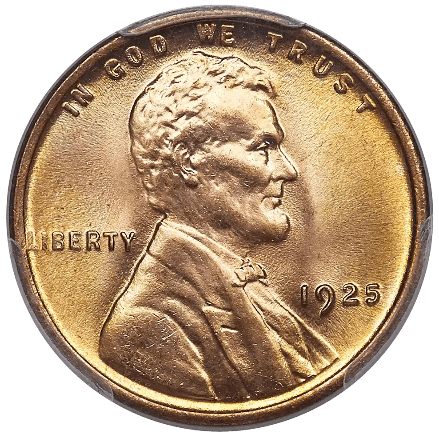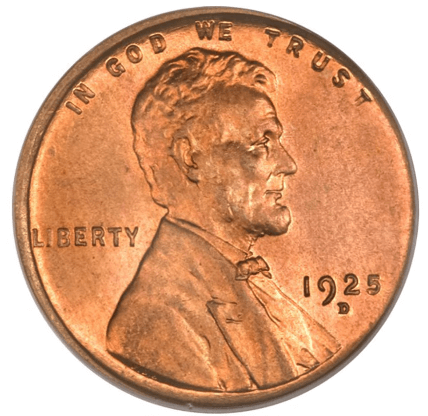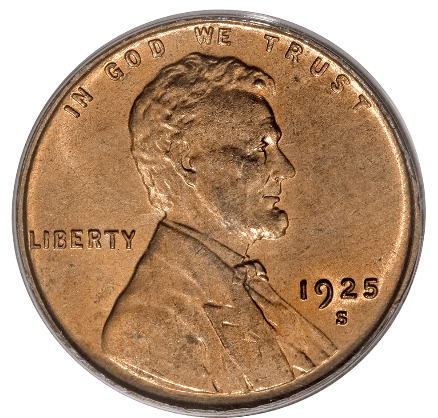1925 Penny Value – In 1925, mintage levels ultimately recovered above 100 million, making the numerous date-and-mint mark combination types extremely affordable. The 1925 wheat penny, as well as the 1925 D and 1925 S wheat pennies, were all produced by the United States Mint. On the obverse side of the coin beneath the date, a mint mark, if present, may be seen.
For penny collectors on a budget who want to quickly fill some gaps in their Lincoln Penny albums or folders, this is excellent news, is a 1925 penny worth money?
In reality, in reasonably to lightly circulated grades, all three 1925 date-and-mint mark combination varieties – 1925 (Philadelphia), 1925-D (Denver), and 1925-S (San Francisco) – may be purchased for less than $1.
Those low prices probably come as no surprise to you upon finding out that the 1925 Lincoln Cent originally numbered 139,949,000; the Denver and San Francisco Mints posted smaller, but still impressive figures of 22,580,000 and 26,380,000, respectively.

The US minted the 1925 wheat penny with no mint mark and also the 1925 D wheat penny and the 1925 S wheat penny. The mint mark, when present, can be found on the obverse side of the coin below the date.
1925 Lincoln Penny History
Abraham Lincoln’s centennial birthday and President Theodore Roosevelt’s desire to commemorate him were celebrated in 1912( see 1912 penny value ).
As a result, he came up with the notion of replacing a one-cent coin with a picture of an adored American President. That prompted a shift away from having genuine persons on American coinage in the past.
Victor David Brenner, a sculptor, was commissioned by President Roosevelt to create the design. On the simple and succinct obverse, you may see Lincoln’s picture. Above the President’s head, the motto “IN GOD WE TRUST” appears on the coin rim. The minting year and mint mark, if there is one, are positioned on his left side, along with the word LIBERTY.
On the reverse side, there are two wheat branches. The inscription UNITED STATES OF AMERICA appears below the ONE CENT denomination in the center. The unavoidable motto E PLURIBUS UNUM appears on the upper rim.
1925 Lincoln Penny Types
The coin you have and the condition it is in will help you determine its value because there were up to 3 different types of Lincoln pennies minted every year. To better understand what you might be charged with purchasing a 1925 Lincoln, the table below will split the coins into grades and types.
In decent condition, all 1925 wheat pennies are ubiquitous. Those are the pennies that are truly rare! They have only minimal wear or are uncirculated (mint).
In both worn and uncirculated conditions, here is a breakdown of how much 1925 Lincoln wheat cents are worth:
- 1925 no mintmark penny (Philadelphia Mint) — 15 to 50 cents in worn condition; $10+ in uncirculated condition.
- 1925-D penny (Denver Mint) — $2.50 to $15 in worn condition; $50+ in uncirculated condition.
- 1925-S penny (San Francisco Mint) — $1.75 to $12 in worn condition; $100+ in uncirculated condition.
Coins that have not been cleaned, have holes, deep nicks or scratches, or suffer other forms of damage are shown above. Coins that have been damaged or cleaned are worth much less.
1925 Lincoln Wheat Penny with No Mint Mark
The value of a 1925 Lincoln Cent Wheat Penny is determined by its color: red-red, brown, or brown. 1925 Lincoln pennies are very common in the present coin market, with a circulation of 139,949,000 pieces from the Philadelphia mint. Finding mint state specimens, however, may be difficult since they were in circulation for years.
A $0.15 example in G4 ( decent ) is worth a lot. All other grade values will fall between those two, with an MS63 Brown (Mint State) worth $14. Brown coins have the values stated above, however, red/brown or red coins will be worth more. Moreover, PCGS or NGC grading firms will have to grade valuable specimens.
One of these pieces has an auction record to be proud of. In 2021, a specimen with an MS 67+ rating was auctioned for $5,520.
Pennies were minted from 1909 until 1958, with the exception of 1943, and were known as Lincoln Wheat Cents.
Steel planchets were used to strike them in 1943. Copper is a common name for the alloy, although it is technically bronze.
1925 D Penny Value
In 1925, the Denver mint produced the lowest number of Lincoln pennies. The letter D is used to differentiate between the different mints, however, there are only 22,580,000 specimens. As a result, their presence on the coin market has minimal effect on their value since they are so common.

Depending on the condition, this item might sell for $0.8 to $2,760. The auction record was severely harmed by such a low circulation. As a result, a specimen with an MS 66 rating was sold for $74,750 during the 2009 auction.
1925 S Penny
Just over 26 million coins were struck at the San Francisco Mint in 1925-S Wheat Penny, making it one of the rarest U.S. coin strikes. Until reaching the highest Mint State grades, this coin appears to be much easier to come by in most grades.

When the grade increases, prices are likely to climb, as seen by the 1925-S Wheat Penny, which sells for around $54,000 in Mint State coins.
- Type of coin: Penny
- Year: 1925-S Wheat Penny
- Wheat Penny Mint Mark: San Francisco
- Total mintage: 26,380,000
- Metal content: 95% Copper, 5% Tin and Zinc
- Face value: 1 cent
- Weight: 3.11 grams
- Edge: Plain
- Designer: Victor David Brenner
- Diameter: 19.00 millimeters
History of the 1925-S Wheat Penny
Due to the S-mint mark, the 1925-S Wheat Penny is a popular coin. It’s beneficial to cherrypick for a coin with a nice strike and appealing surfaces, especially on the reds, when hunting for this one.
Victor David Brenner created the Wheat Penny. President Theodore Roosevelt desired to develop new coin designs with more artistic value.
Based on a plaque he made with Lincoln’s face, he picked Brenner. On the obverse of the Wheat Penny, a bust and profile of Abraham Lincoln are depicted, with the S mint mark beneath the date. Two durum wheat stalks are depicted on the back.
1925-S Wheat Penny Worth
The 1925-S Wheat Penny price varies from $3,000 to $54,000, which is a huge range of prices compared to the 1925-D Wheat Penny. Brown Mint State varieties are significantly less expensive than uncirculated, Mint State grades of Full Red varieties. A valuable addition to any Wheat Penny series collection is the 1925-S Wheat Penny, which is a valuable coin.
1925 Penny Value: Condition
The condition of the devices, the legend, and the fields must all be assessed against a grading standard in order to grade a coin. Images of your coin are used to contrast differences in how much the surface is worn. Determining a grade accurately is necessary for obtaining an accurate value.
When you first see your coin, an overall impression is crucial. Even color and no distracting markings are positive indicators.
– Uncirculated Grade: Finding a mint state – an uncirculated example of an Uncirculated Grade is one of the joys of collecting wheat pennies. Collectors go crazy over these top-grade cents. A coin must be free of wear on any portions of its surface to be eligible for this grade.
Lincoln’s face is high in profile and prone to early wear from touch, as seen in many areas. Narrowing your focus to his eyebrows is one point to judge. Slowly tilt and rotate the coin while holding it at a 45-degree angle to a single light source.
The eyebrows have a color change, and the metal has a smooth appearance due to any wear to the surface. The eyebrows’ raised roundness indicates that there is no wear.
The strong characteristics of Lincoln, as well as the well-raised legend and date, are visible on this 1925 penny. The entire design has been revealed thanks to a powerful strike. An attractive coin with original luster remains.
– Extra Fine: Apart from those in mint condition, collectors search for these Lincoln pennies the most. The coin surface was affected by short-term circulation, although you may not perceive it with the naked eye. Lincoln’s eyebrow is the first flattening location.
– MS 60 Uncirculated: There are no indications of wear on MS 60 Uncirculated. There may be a few stains, abrasions, or surface marks on the coin. It has luster.
– MS 63 Choice Uncirculated: MS 63 Choice Uncirculated: There are minor flaws or contact marks in the main focal regions. The coin’s luster might be less evident.
– Good Grade: A wheat cent in the Good grade denotes heavy wear that levels most of the design. Along with a legible legend and date, a clear idea of Lincoln survives. The forehead and cheek of Lincoln have faded eyebrows. His raised, high-profile eyebrows are now merged into a smooth area of skin.
See Also: 1926 Penny Value, 1929 Wheat Penny Value, 1944 Wheat Penny Value, 1927 Penny Value, 1928 Wheat Penny Value
The worth of lower-grade wheat cents is enhanced by visual qualities. For coins with no distracting markings, check the surface on both sides, as well as the rims, before appealing to collectors.
For the grade, a wheat cent that is free of significant markings is ideal.
A List Of 1925 Wheat Penny Varieties
A difference between a mistake and a variety is that:
- When something goes awry during the striking process or elsewhere in the production of an individual coin, errors are produced.
- Various types are created based on the fundamental principle of a coin, which is then replicated across many specimens, if not hundreds or thousands.
To keep an eye out for in 1925, here are a few:
1925 Penny with Die Breaks Or Die Cracks
These sorts of die variations are more indicative of the condition of the die (a.k.a. Stampers (metal stamping tools) Overworked, overstressed dies or coin dies that are older are more likely to break.
Before the die shatters or is replaced with a new die by a mint employee, the cracks (or breaks) may normally be observed progressing from minor to more severe.
In theory, a succession of distinct coins produced by the same die might provide stronger evidence of the die crack deepening. As a result, the location, size, and prominence of die breaks are taken into account. Several of the die breaks may be insignificant, having no added significance.
Because all die cracks are relatively uncommon, a coin with any kind of die break on any portion of the coin is normally worth keeping. The worth might vary from $5 to $15 for minor die breaks, and from $100 to $200 for major die breaks.
For popular die breaks that are frequently collected, these rules go out the window. For example, with the Delaware quarter from 1999, the size and popularity of that variety were critical factors to consider. Several specimens of this currency were selling for hundreds of dollars when they were discovered!
1925 Doubled Die Penny
The doubled die is one of the most popular Lincoln penny varieties. 1925 is a particularly scarce year because it doubled the pennies! An extra eyelid near Lincoln’s eye is one of the most well-known examples of 1925 doubled die.
Similar doubled dies frequently sell for $50 or more, and these particular pieces don’t trade in the market very often.
A List of 1925 Wheat Penny Errors
Remember I mentioned earlier that mistakes can add to a coin’s worth? So, yes, there are some Lincoln cents out there that were not manufactured correctly (and coins with flaws are worth at least a bit of extra money!).
Little mistakes that occur on old coins from time to time are treasured by coin collectors ( most valuable foreign coins ).
Here’s a list of the 1925 error coins’ value.
1925 Lincoln Penny Struck On The Wrong Metal
When a plate from a previously minted coin stayed in the minting machine, an uncommon error type happened. On the blank tiles for the Mercury dime, the penny appeared as an error in most cases. These error coins have a high value, frequently reaching $500 to $1,000.
1925 Penny With Missing Letters
The majority of these elderly pennies are heavily worn and have only lost letters as a result of their heavy use. Coin dies that were partially filled with grease or other foreign matter may have struck a few of them. Die errors with grease in them might cost $50 to $100 or more.
Because these sorts of mistakes can only be validated by seeing the coin in hand or maybe having a really good picture of it, if you discover a 1925 wheat cent with missing letters, it’s recommended that you get it examined by a numismatic expert (such as a seasoned collector or coin dealer).
1925 Doubled Die Lincoln Penny
It’s one of the most prevalent blunders among Lincoln pennies, yet 1925 pieces are rare. The most popular variety is one with a double Lincoln’s eyelid. They’re not particularly common in the coin market, and a coin costs around $50.
1925 Lincoln Penny With The Re-Punched Mint Mark
Both mints that used the mint mark are susceptible to such coin errors. As a result, both the D and S double dies from 1925 may be found. These specimens are worth $5 to $20.
1925 Penny Struck Off-Center
If only you could see the design floating in thin air alongside the coin, these cool errors would show a portion of it missing (as if it would be hanging off the side of the coin!). The amount of the design that is missing and if the date is still visible play a big role in determining the value of an off-center error coin.
For off-center strikes, the greater the degree of off-centeredness (as long as the date is still completely legible), the greater the coin’s worth. 1925 off-center pennies range in value from $5 to $10 for a minor off-center error (5% to 10%) to several hundred dollars.
FAQ:
Is a 1925 Penny Rare?
The Coin Was Minted at the Philadelphia Mint, but No Mark Is Present. The Philadelphia 1925 cent was produced in 139,949,000 copies and distributed. According to its original mintage numbers, it is rare on the rarity scale. Collectors may still afford to buy these coins today. The early Lincoln cent series, on the other hand, needs them.
Are Coins From 1925 Worth Anything?
The worth is about $37 in really nice condition. For coins with an MS 60 grade, uncirculated specimens cost around $45. Uncirculated coins with an MS 65 rating may sell for around $160.
As a result, you may inquire, “Is there any difficulty in obtaining 1925 Lincoln Wheat Pennies?” Yes, of course, and it’s the uncirculated 1925 Lincoln Cents that you can find in abundance, although they aren’t always in the best shape.
Pre-1934 Lincoln Cents are known for their yellowing, which is in line with the fact that they are (a) so ancient and (b) were not always stored properly – in sulfurous paper rolls, sometimes. As a result, be picky when it comes to the price of a 1925 Lincoln Penny in excellent condition.
Related:
1958 Penny
1959 Penny
1920 Penny